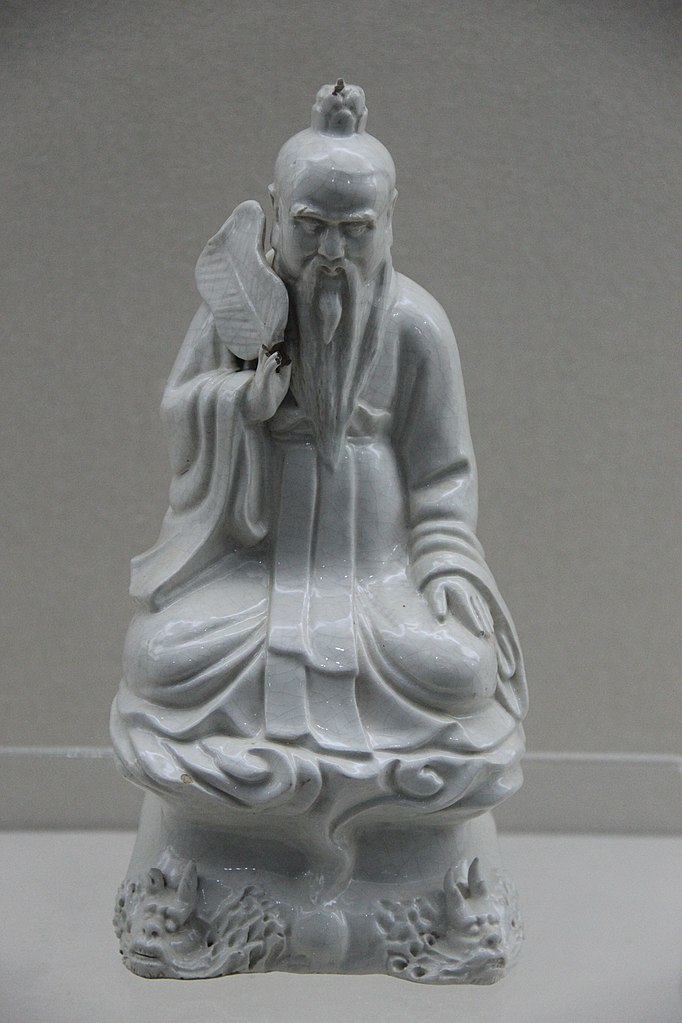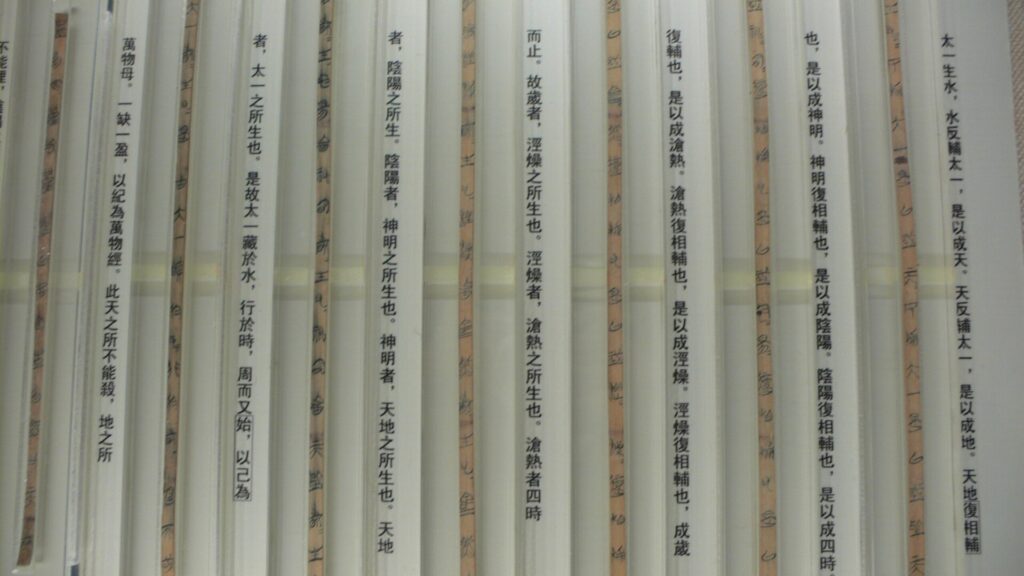
The valley spirit never dies;
We call it the mysterious female.
The gates of the mysterious female –
These we call the roots of Heaven and Earth.
Subtle yet everlasting! It seems to exist.
In being used, it is not exhausted.
(Translation by Robert Henricks)
Ames & Hall point out that this chapter should be looked at in conjunction with chapters 4 and 5, as a “Daoist celebration of the fecundity of emptiness. The underdetermined nature of experience, like a self-emptying flask or a pair of bellows, makes it inexhaustibly productive.”
Ho-shang-kung’s interpretation
Alan Chan first focuses on this chapter in the pages he devotes to Ho-shang-kung’s commentary. He writes:
“According to the Lao-tzu, ‘the spirit of the valley never dies; it is called the mysterious female’. These cryptic remarks present little difficulty to Ho-shang-kung: ‘Valley’ means to nourish. If one could nourish one’s spirits, one would not die. ‘Spirit’ means the spirits of the five inner organs … If the five inner organs are all damaged, then the five spirits will be gone. This means that the way of immortality lies in the mysterious female. ‘Mysterious’ refers to heaven; in man it is the nose … ‘Female’ refers to earth; in man it is the mouth.”
The metaphor of an explicitly female spirit in a “valley” in connection with the concept of fecundity was undoubtedly inspired by the shape of a female womb out of which life arises. Ho-shang-kung’s interpretation, however, is keen to broaden the image of the womb into that of a hollow space, which for men is the nose and the mouth. And what comes out of these is “spirit,” another word for breath, that is, the vital energy called ch’i.
Chan comments: “[Ho-shang-kung’s] commentary is characteristically specific, and again reflects its rootedness in a Han setting … The reference to the ‘nose’ and ‘mouth’ brings into sharp relief that the energy-essence is visualized concretely as breath. Details aside, the human body is thus understood as a ‘sacred vessel’ (chapter 29), animated by indwelling spirits. If life is constituted by energy, death occurs when it dissipates or, which amounts to the same thing, when the spirits depart from the body and ‘return’ to their cosmic source … Sickness and health … depend on the influence of the ‘five spirits’; anger and other emotions are but stirring of the energy within; and even such phenomena as success and failure, fortune and misfortune, can be approached from the perspective of the operation of the vital energy.”
It is such an interpretation of life as the direct result of one’s store of vital energy that led some Taoists to assert that immortality was possible. In addition, it could be argued that, as Chan explains, “if the Tao is eternal, and if the ‘One’ makes possible embodying the Tao, it would follow that human beings can truly aspire to ‘return to the infinite’ (chapter 28). Since “embodying the Tao means literally possessing spiritual essences in one’s body, so long as they remain in the body, death simply cannot happen.”
Even though quite a few chapters of the Tao Te Ching include the possibility of immortality (Chan quotes chapters 7, 16, 33, 44, 50, 55, and 59), Chan says that, for Ho-shang-kung, the Tao Te Ching cannot be seen as a “manual for immortality.” He writes: “Ho-shang-kung’s commentary here is decisive: ‘This states that the ten thousand things ought to follow their ‘allotted’ time of life and death, and must not only want to live perpetually for time without end … Life and death form a part of the transformation processes which constitute the Taoist world. Death, as much as life, belong to the realm of ‘naturalness’, that which is ‘so of itself’ (tzu-jan), a concept which Ho-shang-kung positively identifies as the key to Taoist wisdom. The ‘constant’ Way, one must not forget, is not just about ‘long life’, but “the way of naturalness and long life.”
Wang Pi’s interpretation
Now, how did Wang Pi interpret the “valley spirit that never dies?” As explained earlier (see Chapter 1), while Ho-shang-kung’s commentary is described as “referential” – looking at what the Tao Te Ching refers to in terms of concrete, specific and practical for self-cultivation, Wang Pi’s commentary is said to be “hermeneutic” – seeking to understand the sense in which the image expresses a deeper idea, which relates to “naturalness.”
Wang Pi’s commentary on chapter 6 is a good example of his radically different approach of the Tao Te Ching when compared to that of Ho-shang-kung. Chan writes: “The ‘spirit of the valley discloses to Ho-shang-kung a map of the spiritual body and a guide to naturalness and long life. For Wang Pi, the words bring to mind rather the image of ‘the middle of the valley’, which suggests the idea of ‘nonbeing’ or ‘nothingness’ (wu). Once the chains of reference are broken, the commentator is free to pursue the perceived deeper meaning of the text. Together, nonbeing and naturalness form the twin foci of Wang Pi’s Lao-tzu commentary.”
So, what does wu mean? Chan asks, and he answers: “Grammatically, the word functions both as a transitive verb and as a noun. Wu and its opposite yu mean basically ‘not having’ and ‘having’ something, and ‘nothing’ and ‘something’. Disagreement, however, arises when they are extended to represent metaphysical concepts. If wu means ‘nothingness’ or, as many scholars prefer to translate ‘nonbeing’, does it have a positive meaning, or even reference? In Ho-shang-kung’s commentary, it is viewed positively in terms of ch’i energy. Even if ‘nothing’ can be seen or described, ‘something’ is certainly there to bring about created order. Can the same be said of Wang Pi’s understanding? Inasmuch as yu is most simply rendered ‘being’ at the ontological level, wu may be translated as nonbeing. This does not, however, prejudge its meaning or rule out other translations.”
For Wang Pi, what brings about the created order is language. Words, as it were, translate the formless Tao into the forms of the ten thousand things, through “naming” them. This is reminiscent of the Buddhist understanding of reality. Likewise, Nagarjuna shows how we superimposed a layer of concepts over the formless reality in order to cope with life’s practical issues and communicate. As is the case with Buddhism, Wang Pi is also aware of the “inadequacy of language.” Chan writes: “‘Names’, Wang Pi states, serve to determine form. Completely undifferentiated and without form, the Way cannot be pinned down and determined (chapter 25). Although such words as ‘deep’, wondrous’, and ‘great’ may be useful in providing glimpses of the Tao, ‘they do not exhaust the meaning of the ultimate’. Even the word “Tao” is to be used with caution and not turned into a divisive and limiting ‘name’ (chapter 25). Indeed, ‘If one speaks of Tao, one loses its constancy; if one were to name it, one misses its truth’.”
We nevertheless need words that organise our awareness of reality into a meaningful whole, and give non-being a simulacrum of “being.” Chan concludes: “Philosophically, Wang Pi argues, ‘As nonbeing cannot be made manifest by nonbeing itself, it must be mediated by beings’. While the ‘nonbeing’ of Tao cannot be compromised, this should not obscure the fact that its power or ‘constancy’ is manifested in nature. In this way, a dialectical reading of the Lao-tzu begins to take shape, by which Wang Pi is able to affirm both understanding and the possibility of following Tao in individual action and government.”
Sources:
Robert G Henricks – Lao-Tzu, Te-Tao Ching
Alan K L Chan – “A Tale of Two Commentaries: Ho-shang-kung and Wang Pi on the Lao-tzu in Lao-tzu” and the Tao-Te-Ching, ed. Livia Kohn and Michael Lafargue
Roger T Ames and David L Hall – A Philosophical Translation – Dao De Jing – Making this Life Significant

